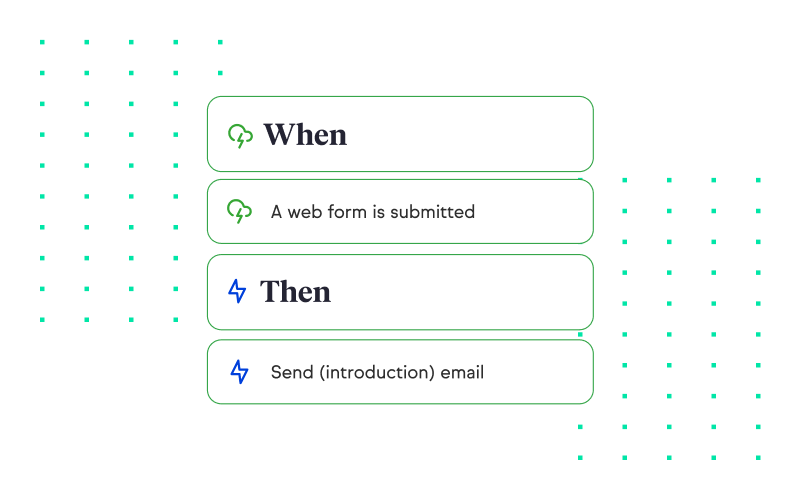Not to toot our own horn, but at Keap we’ve been helping small businesses grow with marketing automation for over 20 years.
So naturally, we’ve seen countless examples of businesses successfully adopting automation and accelerating their growth.
But we’ve also seen our fair share of examples where the circumstances were ripe for automation, and for one reason or another the business didn’t get the results they were after.
Let’s take a look at a few of the more common marketing automation mistakes we see get in the way of the growth and progress that automation should facilitate.
1. Trying to Automate Everything
Entrepreneurs and small business owners tend to be ambitious. And in the vast majority of situations, this is a positive characteristic.
But when it comes to adopting marketing automation, what happens is that ambition can lead us to create grand, lofty plans.
We’ve seen small businesses get swept up in excitement and draft plans for automating nearly every aspect of their business—which might be where you want to end up, but when you have plans that are that bold, it can take a while to get there.
And when the finish line is that far away, there are more opportunities for obstacles to emerge and it’s easier to lose momentum.
So our advice is to keep your initial plans more manageable.
If you start with smaller more attainable projects, you’ll build momentum, and start experiencing an ROI from your automation efforts earlier than you otherwise might have.
2. Missing the Opportunity to Redesign a Process
Time and time again we see entrepreneurs fall victim to this trap.
We’re generally proud of our processes, so when we go to automate a process that we’ve been managing for years, our instinct is to take the steps that we were doing manually and use automation to perform the same steps.
But when we take this approach, we miss a critical opportunity to improve on our existing systems and fall into another marketing automation pitfall.
See, when you do something manually you are bound by a set of natural constraints.
Humans can only work so quickly. We can only manage so many things simultaneously. And we only have so many hours in the day.
But when you are using automation to accomplish the same thing, the constraints change.
And this presents us, the automation architect, with the opportunity to reimagine this process using the new set of rules.
So when you’re adopting automation, make sure to carve out time to challenge the existing ways you’ve been doing things and see if there’s an easier way to get the same result.
3. Automating only the ideal customer journey
When most businesses layer automation into the journey they’re designing for their leads, prospects, and customers, it tends to be built in a series of “if they do this, then this thing happens” logic statements.

If they fill out this form, then we add them to our blog subscriber list.
If they click this link, then we get a task to call them.
If they buy this course, then they get access over here.
And there’s nothing wrong with this. In fact, it’s smart to plan out the actions you want your audience to take and to automate the reaction you want to have as a result.
But the risk and the marketing automation mistake we’ve seen people make is that if you stop there, you wind up creating gaps and miss the opportunity to design a contingency plan.
See, some people will take the actions we want them to take.
They’ll take the survey we send them. They’ll download the ebook they requested. And they’ll show up for the appointment they booked.
But despite their best intentions, some people also won’t.
And automation’s job is to limit the number of cracks that people can slip between. We do that by asking ourselves “what happens if they don’t do the thing”, and then designing the failsafe.
Automation shouldn’t slow down your most motivated customers, but for the customers who need just a little more time, it should help them feel supported and prevent them from losing momentum.
In Short...
The summary version of the advice is to:
- Be strategic about the priorities you start with so that you can build momentum early
- Take the time to redesign the process you’re automating
- Use automation to design contingency plans, rather than just the ideal customer experience
If you haven’t yet, you can dip your toe in the automation pool by signing up for a Keap Free Trial today.
Start a free 14-day Keap trial
About the Author

Greg is the founder of Monkeypod Marketing, where he focuses on empowering entrepreneurs through online courses and educational resources. More specifically, he helps small businesses understand and use automation in different ways, and at higher levels, to maximize the return on efforts.
Prior to starting Monkeypod, Greg worked at Keap as a curriculum developer and lead trainer for Infusionsoft University. In addition to small business and marketing automation, he loves hiking, traveling, watching basketball, and binging Netflix. And also dogs, he really loves dogs.


